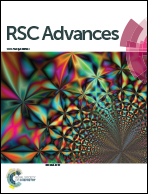AIE-active conjugated polymer nanoparticles with red-emission for in vitro and in vivo imaging†
Abstract
A novel red-emission conjugated polymer (PBPTPE) with aggregation-induced emission (AIE) characteristics was developed from boron dipyrromethene (BODIPY) derivatives and 1,2-bis(4-ethynylphenyl)-1,2-diphenylethene via palladium-catalyzed Sonogashira coupling reaction. The resulting polymer (PBPTPE) was weakly fluorescent in dichloromethane solution, but showed bright fluorescent emission when aggregated in dichloromethane/hexane mixtures or fabricated into conjugated polymer nanoparticles (PBPTPE NPs). The nanoparticles from PBPTPE were prepared through solvent-exchange method. PBPTPE NPs possess excellent photostability, including superior photobleaching resistance, and good stability in a wide pH range. Besides, in vitro cytotoxicity and hemolysis assay indicated that PBPTPE NPs had favorable biocompatibility. Furthermore, biological evaluation and bioimaging were performed using developmental stage zebrafish embryos. From the survival and hatching rate, oxidative stress and immune-related parameters, no significant adverse effect was observed. The microangiography in zebrafish, further shows that PBPTPE NPs can be used as a bioprobe for future in vivo applications.


 Please wait while we load your content...
Please wait while we load your content...